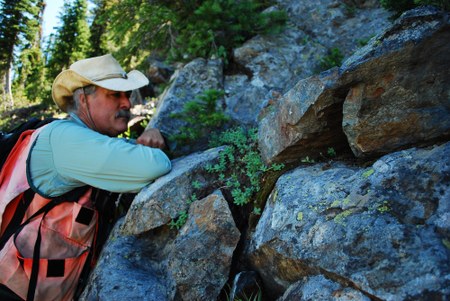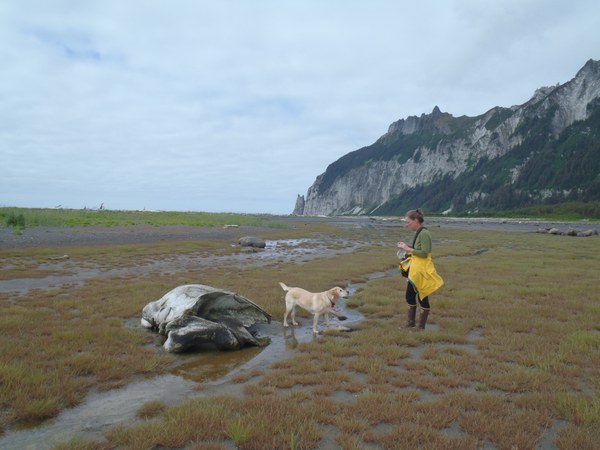
Rare Plants: Between a Rock and a Hard Place
When worlds collide, it’s usually a bad thing. But when geology and botany come together for Mark Darrach, he’s as happy as a Polystichum lemmonii on an ultramafic substrate.
A geologist and botanist, Mark is busy documenting the relationship between rare plants and unusual geologic settings. He devotes part of every year to field research in spectacular mountain locations of the western states. But as a research associate with the Burke Museum, he also spends time indoors, examining and classifying specimens in the museum’s botany collections, housed in the University of Washington’s Herbarium.
Mark was one of those kids whose childhood forays into nature set him on a life path of conservation. “I’ve cared about nature since I was a little boy,” he says. “At six years old, my dad starting teaching me all the tree species in the various places where I grew up. I have a deep appreciation of wild areas and biodiversity.”
His passion is, in part, channeled into studying unusual geologic settings such as ultramafic terranes, which have “unique chemistry that drives the evolution of plants strictly on those sorts of substrates.” Ultramafic rocks are not common, but some can be found in the North Cascades and elsewhere along the west coast. These rocks have been derived from the earth’s mantle by subductions processes, and have usually been metamorphosed by the time they reach the surface, Mark explains. Typically they have been transformed into serpentine, which is rich in iron and magnesium and, often, phytotoxic trace elements such as nickel, chromium, and cobalt.
“This particular chemistry fosters the evolution of unique plant species. But, when those plants evolve in that setting, they’re essentially marooned on that particular substrate. They can’t cross over to other more common substrates because they have a particular suite of adaptations that have allowed them to live on these unusual and chemically challenging substrates.” And that can spell trouble for such plants as climate changes unfold.
Climate change, as it relates to vegetation, is a sub-focus of Mark’s research. He participates every year in the international GLORIA project (Global Observation & Research in Alpine Environments) on various mountaintops in the western U.S. Every five years, teams of scientists at sites in California, throughout the mountain west, and across the globe monitor changes in alpine plants via the GLORIA protocol. This summer, Mark worked on the second measurements above timberline in the Sweetwater Mountains of far eastern California, where unique rocks and clay-rich soils support diverse and rare vascular plants. He also conducted a GLORIA remeasurement along the crest of the Panamint Range along the western margin of Death Valley National Park. “We’re looking at plants that are most at risk for climate change. They’re likely to disappear as the planet warms.”
In addition to his field and herbarium work, Mark is helping update "Vascular Plants of the Pacific Northwest," the well-known technical guide for the flora of the region.
Every year in North America, north of Mexico, somewhere between 30 and 60 new species of plants are described by scientists. There are unknown numbers of species that still haven’t been documented, offering much opportunity for scientists and amateurs to contribute to biodiversity knowledge. “For me, it’s all about preserving biodiversity,” Mark says. “If I can put a name on a plant, get it published and recognized, that plant has at least a leg-up on not going extinct. Most recently described plant species are rare. Seeds will be archived and will have a chance of surviving accordingly.”

Marine Birds and a Warming Ocean: The Power of Citizen Science
On any given day, dead seabirds wash ashore or, in scientific lingo, are “beachcast”. In what began as an effort to document what was happening with seabird populations along the west coast – asking questions like, “What kind of bird was it? Why did it die? Where did it come from?” – has grown to a group of more than 1,000 participants on 450 beaches helping scientists reveal annual patterns and document the impacts of climate change and other factors on seabirds.
COASST, short for Coastal Observation and Seabird Survey Team, is a citizen science program founded in 1998 by Julia Parrish. A marine biologist, Parrish studies change in marine ecosystems, with marine birds serving as indicators of environmental health. A couple of decades ago she was focused on seabirds in Washington. But she soon saw a need for a larger scope initiative, and that led to the formation of COASST. Today, she is COASST’s executive director and a professor of ocean fishery sciences at the University of Washington. In 20 years, her vision has blossomed into a wide-ranging citizen science program across four states.
COASST was developed to provide baseline data about birds that could be used in the event of an oil spill. But since then, Parrish says, COASST data has contributed to a variety of resource management issues. The program is so successful, that it’s been expanded to add data about marine mammals and beach debris.
Parrish recounts that in 2013, an oceanic event produced one of the greatest impacts on seabirds ever documented. “That’s when a very large body of unusually warm water, known as ‘The Blob,’ developed in the northeast Pacific Ocean, resulting in harmful algal blooms, fishery collapse, and mass mortalities of marine mammals.”
At its height, the Blob covered an area the size of Canada and was up to four degrees warmer than normal. “That doesn’t sound like a lot, but aquatic organisms are not adapted to such change.” Parrish compares a rise of four degrees in ocean temperature to a similar rise in the human body. “That would put you in the hospital.”
The impact on seabirds was devastating. Five mass mortality events between 2014 and 2017 totaled in the millions of birds, says Parrish. That was the largest avian response to ocean warming ever documented. “We know this because thousands of coastal residents from California to Alaska have diligently collected data on beachcast marine birds on a monthly basis as part of COASST.” Volunteers are the heart of COASST, and carry out vigilant observations in Alaska, Washington, Oregon, and California.
In such cases, all carcasses except a few collected for study are left in place. “Death is part of the life of the ecosystem,” says Parrish. “The carcasses become food for everything from grizzly bears to kelp flies. The first thing we tell people is to consider the ecosystem when you see a carcass on the beach. It’s not about burial or removal. It’s about keeping something there. It’s also about figuring out what it is, and that’s what COASST is about. Participants get trained on how to survey a beach and if they find carcasses, how to identify them, and do that in a framework that involves no guessing. COASST is evidence first, scientific deduction second.”
As climate change drives more and more change in marine life, COASST’s data is no doubt vital to policy making. “I would say we are a ‘witness’ program,” Parrish says. “We bear witness to what’s going on in the environment and then, we tell those stories. We’re not silent witnesses. We’re very vocal witnesses to what’s going on.”
This article originally appeared in our Fall 2018 issue of Mountaineer Magazine. To view the original article in magazine form and read more stories from our publication, click here.
 Joan Miller
Joan Miller